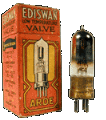|
[ Saftey
| Basics
| Transformers
| Speakers
| Coils
IF & RF |
Caps
| Resistors
& Pots |
Valves
]
 If its got valves, its got hundreds of volts. Which
kill. Add to that the sometimes dubious electrical
safety of some vintage equipment, made worse still
by deterioration over time, and the danger should be
all too clear. If you're not sure, don't touch it !
And never be tempted to simply
switch long dormant equipment on ... if you're lucky
you'll only damage possibly irreplaceable parts. But
typically it'll go bang. And if you're unlucky ....
!
If its got valves, its got hundreds of volts. Which
kill. Add to that the sometimes dubious electrical
safety of some vintage equipment, made worse still
by deterioration over time, and the danger should be
all too clear. If you're not sure, don't touch it !
And never be tempted to simply
switch long dormant equipment on ... if you're lucky
you'll only damage possibly irreplaceable parts. But
typically it'll go bang. And if you're unlucky ....
!
 IMPORTANT
When dealing with mains-connected equipment
safety is of paramount importance. Check and
double check connections and then operate with
one hand in your pocket. If at all possible use
an isolating transformer. First check the
condition of the mains lead and plug. If any
cracking of insulation, bare spots or general
deterioration is evident, renew them. American
sets often used mains cords with only cotton
insulation. These should be replaced. Inspect
the mains plug for wrong connections. If the
earth lead is connected wrongly the chassis
could become lethal. With your test meter set
to the highest resistance range, check for any
leakage between the live leads and the chassis.
If there is then look for faulty bypass
capacitors between the mains leads and chassis.
These were common on American receivers. There
could be a faulty on/off switch causing leakage,
or, if storage has been in a damp situation,
there could be moisture in the transformer. If
moisture is suspected direct a blower heater on
to the transformer for a few hours to dry it
out. P.L IMPORTANT
When dealing with mains-connected equipment
safety is of paramount importance. Check and
double check connections and then operate with
one hand in your pocket. If at all possible use
an isolating transformer. First check the
condition of the mains lead and plug. If any
cracking of insulation, bare spots or general
deterioration is evident, renew them. American
sets often used mains cords with only cotton
insulation. These should be replaced. Inspect
the mains plug for wrong connections. If the
earth lead is connected wrongly the chassis
could become lethal. With your test meter set
to the highest resistance range, check for any
leakage between the live leads and the chassis.
If there is then look for faulty bypass
capacitors between the mains leads and chassis.
These were common on American receivers. There
could be a faulty on/off switch causing leakage,
or, if storage has been in a damp situation,
there could be moisture in the transformer. If
moisture is suspected direct a blower heater on
to the transformer for a few hours to dry it
out. P.L
There are a few basic safety rules
that will protect you and your new acquisition:
1. Fit your working area with a
single Isolation switch, and make sure all your
family know where it is, what it does and how to use
it! If they can't disconnect you from the power, they
can't give you any other help.
2. Use an Earth Leakage Circuit
Breaker (ELCB) or a Residual Current Device ( RCD)
in the supply to your workshop. These devices will
not prevent you from getting a shock, but they may
well prevent it from killing you. IF YOU DONT YOUR A
BLOODY IDIOT
3.Use an Isolation transformer
between the set you are working on and the mains
supply - this can also help to protect your test
equipment.
4. Keep one hand in your pocket! A
simple rule, but it prevents a path across your
chest and through your heart. Also make a skull &
crossbones sign and put it in a prominent place when
gear is open and live.
5. Never apply power to an unknown
piece of equipment without a first giving it a
thorough visual inspection. Look for frayed or
missing insulation, missing parts, signs of damp,
obviously incorrect parts, or any other signs that
it may have been tampered with.
7. When applying power, do it
gradually, using either a Variac (variable voltage
transformer), or a series lamp. Some even recommend
disconnecting the sets own power supply, and using
an external variable supply to power up the
equipment whilst fault finding (I must admit that a
large number of faults involve the power supply, and
mains transformers are very difficult to replace or
repair!).
8. When working on equipment,
remember health and safety wasn't always well
considered, so beware of live chassis, finger sized
holes in covers and other traps for the unwary.
9.A lot of materials used in older
equipment are now considered to be hazardous to
health, for example, Cadmium in plated parts,
Beryllium in ceramics of power valves and
transistors, Arsenic in thermal pastes, Mercury in older power rectifier valves
(tubes), all sorts of lethal organic chemicals in
capacitors (condensers), not to mention Asbestos in
resistive line cord and insulation around dropper
resistors. It is wise to learn about these
materials, and take the relevant precautions when
handling them!
10. A final simple rule, keep small
children and pets out of the working area, what you
do to yourself is up to you, but injury to others is
unforgivable!
<edited, original author unknown> |
 Main
Menu[
Home |
©redits
|
Search
| Promote
|
Links
|
Guest
Book |
What's New?
]
Main
Menu[
Home |
©redits
|
Search
| Promote
|
Links
|
Guest
Book |
What's New?
]

 If its got valves, its got hundreds of volts. Which
kill. Add to that the sometimes dubious electrical
safety of some vintage equipment, made worse still
by deterioration over time, and the danger should be
all too clear. If you're not sure, don't touch it !
And never be tempted to simply
switch long dormant equipment on ... if you're lucky
you'll only damage possibly irreplaceable parts. But
typically it'll go bang. And if you're unlucky ....
!
If its got valves, its got hundreds of volts. Which
kill. Add to that the sometimes dubious electrical
safety of some vintage equipment, made worse still
by deterioration over time, and the danger should be
all too clear. If you're not sure, don't touch it !
And never be tempted to simply
switch long dormant equipment on ... if you're lucky
you'll only damage possibly irreplaceable parts. But
typically it'll go bang. And if you're unlucky ....
!







